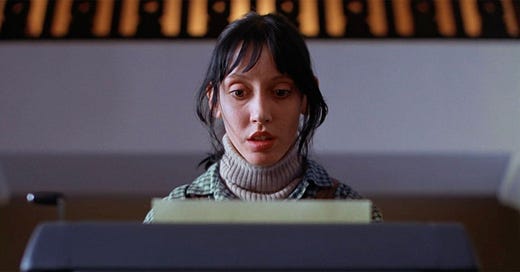Clusterhucktober Spooktacular: The Shining
Kubrick's masterpiece is a maze, and only one woman knows how to get through it.
I didn’t grow up watching a lot of scary movies. This had to do with a mix between a conservative Christian upbringing that was skeptical of Halloween and the simple fact that I was a big scaredy cat. My parents didn’t really want me watching scary movies and that was fine by me.
I don’t really remember when things changed, but I’m very into good horror movies now. I say “good horror movies,” because many of them re bad and I think that holds a lot of people back from getting into the genre. If you grew up like I did and didn’t try to get into horror until later, you could be forgiven for thinking all horror movies are disposable, exploitive slop. A lot of them are, but some of them are the best movies you could ever watch. I wish I’d had somebody there to point me through all the forgettable schlock and towards the good stuff. I didn’t. But now you do.
Through the month of October, I’ll be writing about eight different horror movies that I love. These aren’t necessarily my all-time favorites, but I think they’re all good horror movies for people who don’t necessarily like horror movies or, at least, aren’t super experienced with horror movies. And hopefully, they’re movies made by filmmakers who understand and utilize fear towards substantive, meaningful ends.
The Orphanage (2007)
The Shining (1980)
Rosemary’s Baby (1968)
Signs (2002)
It Follows (2014)
Bram Stoker’s Dracula (1992)
Alien (1979)
The VVitch (2015)
The Shining is a maze, a film of red herrings, trap doors and false exits. Every scene, every frame, every line of dialog is infused with potential double readings and misdirection. Exposition that seems designed to pull your attention one way ends up in a dead end, while an unremarkable easter egg in Act One could be the skeleton key that unlocks the entire plot. One interpretation may lead you to the maze’s exit, or it might lead you in circles. Is that a toy axe on a desk in the first scene? Is that a scrapbook by Jack’s typewriter? Is that a mirror behind the bar? Is the topiary maze in the front of the hotel, or around back? Is this a commentary on the oppression of indigenous people or a coded message about how the moon landing was faked? Are you feeling insane yet? Welcome to the Overlook.
For conspiracy theories and obsessive analysis, The Shining is probably only rivaled by the Zapruder film. It’s a strange legacy for such a straightforward story. Ostensibly, very little actually happens in The Shining. The first act does the heaviest narrative lifting, as we learn that Jack is taking over as the winter custodian of the Overlook Hotel while he works on his novel, and he’ll be joined by his wife Wendy and their kid Danny. We learn that the previous custodian went nuts and killed family. We learn that Danny has an imaginary friend and some sort of mysterious telepathic abilities. That’s about it. From there on out, it’s us, Jack, Wendy and Danny alone in the Overlook. How alone? Well, that depends on your interpretation.
From there on out, Kubrick unspools his story through inference, assumption and a handful of the most iconic visuals in movie history. As Torrance, Jack Nicholson walks a very fine line, keeping us all guessing about just how crazy the hotel is driving him versus how crazy he’s been anyway1. Meanwhile, Lloyd delivers one of the all-time great child actor performances, and you believe every inch of the terror on his face when he sees the twins, the elevator or, most chillingly, his dad.
But the movie belongs to Shelley Duvall. Pages and pages have been written about her oddball performance, the critical drubbing she got upon its release, the subsequent reappraisal of her skill, examination of her on-set treatment, and broader conversation about her unique place in the scream queen canon. The movie nimbly slips between POVs and, on my most recent rewatch, hers was the one that grabbed me.
Keep reading with a 7-day free trial
Subscribe to clusterhuck to keep reading this post and get 7 days of free access to the full post archives.






